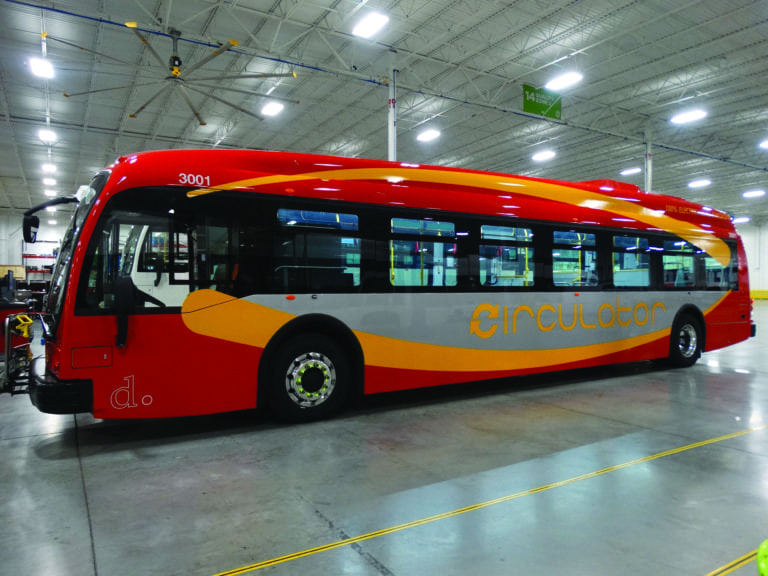Growing interest in high efficiency, pollution-reducing transit options is propelling investment in new electrified mass transit projects across the United States. Reflecting this trend, Black & Veatch announced it has completed the charging station infrastructure that powers Washington, D.C.’s new electrified mass transit project – the latest move by U.S. cities to reimagine how to sustainably move people across urban landscapes with the benefits of clean transportation, both on and off the bus.
The Washington D.C. Circulator System mass transit project combines 14 Proterra Catalyst E2 buses, each having a Proterra-provided 50kw charger installed by Black & Veatch along with the related charging infrastructure. Powered entirely by high-capacity batteries, the buses benefit riders and non-riders alike by eliminating a projected 244,000 pounds of carbon dioxide emission each year. For taxpayers, there’s a bonus: the 14 EV buses will cut the fleet’s fuel and maintenance bills by more than $6 million over the transit vehicles’ typical 12-year life cycle, while displacing nearly 90,000 gallons of diesel fuel annually.
U.S. cities purchase an estimated 5,000 public transit buses each year, and due to the benefits city officials increasingly are prioritizing electrification of their mass transit project offerings. Some 850 municipal electric buses are on order, and there are active proposals for hundreds more. Seattle will roll out 120 new electric buses by 2020, while Los Angeles is buying 95 electric buses for $138 million – a tenet of that city’s quest to replace its 2,300-bus fleet with EVs by 2030. Keeping many such buses rolling is Black & Veatch’s market-leading design and deployment of more than 1,000 charging sites nationwide, including the large-scale, heavy-duty charging infrastructure electric buses require.
Infrastructure solutions like the one being deployed in the nation’s capital are crucial to meeting rising demands for electric vehicles. Success of these projects requires deep collaboration from all stakeholders including transit agencies, utilities, permitting authorities, charging technology providers, engineering and construction services. Each project in the built environment brings unique challenges and adds to lessons learned, which benefits the next transit electrification projects.
“With the arrival of electrified transit, public transit agencies and utilities must work in concert to develop infrastructure roadmaps that guide them beyond early pilots toward mass deployment,” said Paul Stith, Director of Strategy & Innovation.
According to Black & Veatch’s 2018 Strategic Directions: Smart Cities & Utilities Report survey, more than half of smart services providers said the need for charging infrastructure — both via depots and on-route — was the most prohibitive barrier to large-scale electric fleet adoption. The Washington, D.C. project, and others underway, demonstrate that electric buses have lower maintenance costs than their diesel or hybrid counterparts and could change minds about cost. Electric buses that were priced at about $1 million apiece have recently dropped to around $750,000, with upfront cost parity when considering total cost of operation. As demand and production volume increase, economies of scale will widen the gap in favor of electrification. Over time, transit agencies that don’t electrify will be polluting more and spending more on their legacy fleets.
“With the arrival of electrified transit, public transit agencies and utilities must work in concert to develop infrastructure roadmaps that guide them beyond early pilots toward mass deployment. Each system is different and will seek to optimize the best combinations of on-route and depot charging technologies,” said Paul Stith, Director of Strategy & Innovation for Black & Veatch’s Transformative Technologies business and an expert in sustainable transportation and energy storage solutions. “Partnering with an organization with deep EV infrastructure and utility experience like Black & Veatch will ensure infrastructure won’t hold back aggressive EV adoption.”



